
Three-dimensional chess is any chess variant that uses multiple boards representing different levels, allowing the chess pieces to move in three physical dimensions. In practical play, this is usually achieved by boards representing different layers being laid out next to each other.
Grand chess is a large-board chess variant invented by Dutch games designer Christian Freeling in 1984. It is played on a 10×10 board, with each side having two additional pawns and two new pieces: the marshal and the cardinal.

Sittuyin, also known as Burmese chess, is a chess variant created in Myanmar. It is a direct offspring of the Indian game of chaturanga, which arrived in Myanmar in the 8th century. Sit is the modern Burmese word for army or war ; the word sittuyin can be translated as representation of the four characteristics of army—chariot, elephant, cavalry and infantry.
Tamerlane chess is a medieval chess variant. Like modern chess, it is derived from shatranj. It was developed in Central Asia during the reign of Emperor Timur, and its invention is also attributed to him. Because Tamerlane chess is a larger variant of chaturanga, it is also called Shatranj Al-Kabir, as opposed to Shatranj ash-shaghir. Although the game is similar to modern chess, it is distinctive in that there are varieties of pawn, each of which promotes in its own way.
Kriegspiel is a chess variant invented by Henry Michael Temple in 1899 and based upon the original Kriegsspiel developed by Georg von Reiswitz in 1812. In this game each player can see their own pieces, but not those of their opponent. For this reason, it is necessary to have a third person act as an umpire, with full information about the progress of the game. Players attempt to move on their turns, and the umpire declares their attempts 'legal' or 'illegal'. If the move is illegal, the player tries again; if it is legal, that move stands. Each player is given information about checks and captures. They may also ask the umpire if there are any legal captures with a pawn. Since the position of the opponent's pieces is unknown, Kriegspiel is a game of imperfect information.
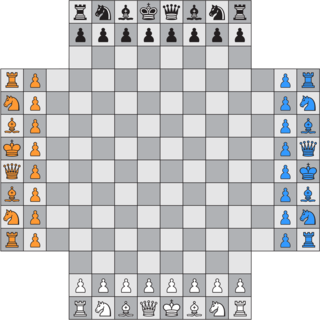
Four-player chess is a family of chess variants typically played with four people. A special board made of standard 8×8 squares with an additional 3 rows of 8 cells extending from each side is common. Four sets of differently colored pieces are needed to play these variants. Four-player chess generally follows the same basic rules followed on regular chess. Exceptions to these rules include nuances of when checkmate is delivered, depending on the variant, on what rank a pawn promotes, and the ability to capture a player's king, which takes priority over checkmate in the teams variant. As in regular chess, pawns are promoted when they reach the 8th square although this is close to the middle of the board rather than the opposite end which impacts how the game is played. There are many different rule variations; most variants, however, share the same board and similar piece setup.
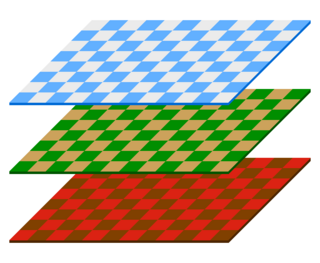
Dragonchess is a three-dimensional fantasy chess variant created by Gary Gygax, co-creator of the famed role-playing game Dungeons & Dragons. The game was introduced in 1985 in issue No. 100 of Dragon Magazine.
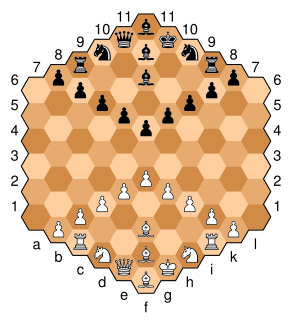
Hexagonal chess refers to a group of chess variants played on boards composed of hexagon cells. The best known is Gliński's variant, played on a symmetric 91-cell hexagonal board.
The grasshopper is a fairy chess piece that moves along ranks, files, and diagonals but only by hopping over another piece. The piece to be hopped may be any distance away, but the grasshopper must land on the square immediately behind it in the same direction. If there is no piece to hop over, it cannot move. If the square beyond a piece is occupied by a piece of the opposite color, the grasshopper can capture that piece. The grasshopper may jump over pieces of either color; the piece being jumped over is unaffected.
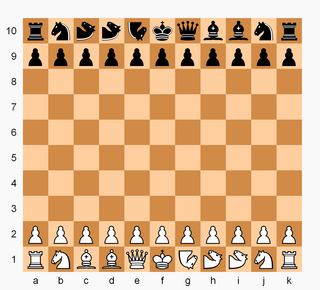
Wildebeest chess is a chess variant created by R. Wayne Schmittberger in 1987. The Wildebeest board is 11×10 squares. Besides the standard chess pieces, each side has two camels and one "wildebeest" - a piece which may move as either a camel or a knight.
Dragonfly is a chess variant invented by Christian Freeling in 1983. There are no queens, and a captured bishop, knight, or rook becomes the property of the capturer, who may play it as his own on a turn to any open square. The board is 7×7 squares, or alternatively a 61-cell hexagon with two additional pawns per side.

Wolf chess is a chess variant invented by Dr. Arno von Wilpert in 1943. It is played on an 8×10 chessboard and employs several fairy pieces including wolf and fox – compound pieces popular in chess variants and known by different names.

Triangular chess is a chess variant for two players invented by George R. Dekle Sr. in 1986. The game is played on a hexagon-shaped gameboard comprising 96 triangular cells. Each player commands a full set of chess pieces in addition to three extra pawns and a unicorn.

Masonic chess is a chess variant invented by George R. Dekle Sr. in 1983. The game is played on a modified chessboard whereby even-numbered ranks are indented to the right—resembling masonry brickwork. The moves of the pieces are adapted to the new geometry; in other respects the game is the same as chess.

Chesquerque is a chess variant invented by George R. Dekle Sr. in 1986. The game is played on a board composed of four Alquerque boards combined into a square. Like Alquerque, pieces are positioned on points of intersection and make their moves along marked lines ; as such, the board comprises a 9×9 grid with 81 positions (points) that pieces can move to.

Tri-chess is the name of a chess variant for three players invented by George R. Dekle Sr. in 1986. The game is played on a board comprising 150 triangular cells. The standard chess pieces are present, minus the queens, and plus the chancellor and cardinal compound fairy pieces per side.
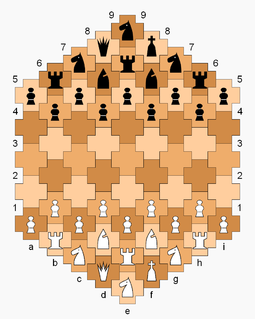
Cross chess is a chess variant invented by George R. Dekle Sr. in 1982. The game is played on a board comprising 61 cross-shaped cells, with players each having an extra rook, knight, and pawn in addition to the standard number of chess pieces. Pieces move in the context of a gameboard with hexagonal cells, but Cross chess has its own definition of ranks and diagonals.

Congo is a chess variant invented by Demian Freeling in 1982 when he was nearly 8 years old. His father encouraged him to design a variant using a 7×7 gameboard. Demian was already familiar with chess and xiangqi, and the result blends some features from both. Congo became the second-most popular chess variant at the Fanaat games club in Enschede, the Netherlands.
Dynamo chess is a chess variant invented by chess problemists Hans Klüver and Peter Kahl in 1968. The invention was inspired by the closely related variant push chess, invented by Fred Galvin in 1967. The pieces, board, and starting position of Dynamo chess are the same as in orthodox chess, but captures are eliminated and enemy pieces are instead "pushed" or "pulled" off the board. On any given move, a player can make a standard move as in orthodox chess, or execute a "push move" or a "pull move". A move that is either a push move or a pull move is called a "dynamo move".














